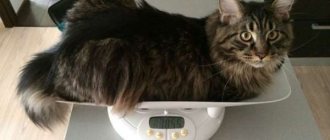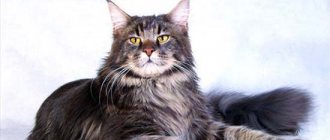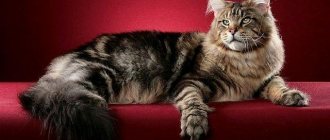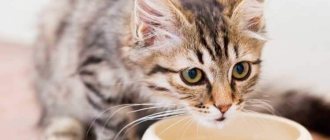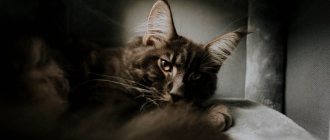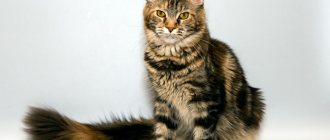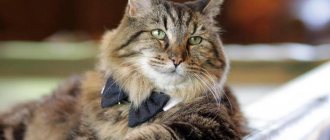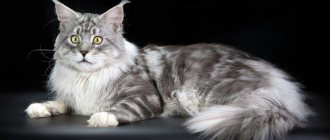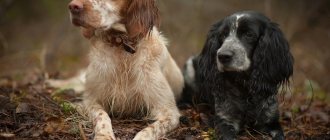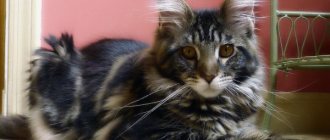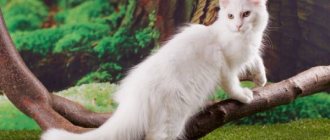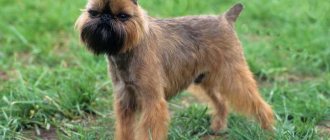Maine Coon cats are gaining popularity. There are many people who want to have such a cat. And demand determines supply, which is expressed both in an increase in the number of the breed and in an increase in the cost of kittens. Few people in the current situation can afford such expenses. Therefore, there is a demand for mixed breeds of this breed. Mixed breeds are not mongrels; they carry the genotype from Maine Coons. It’s worse when they try to sell ordinary cats to buyers under the guise of mestizos—this is obvious deception and fraud. The difference between a purebred and an ordinary cat is very noticeable.
Types of colors and their descriptions
Based on the basic colors of Maine Coons, breeders have developed many new colors of the breed. The most valuable of them are single-color variations and covers with a clearly defined pattern or spots.
Tabby
Tabby is a color with stripes. There are additional features:
- The presence of stripes of medium thickness on the muzzle, which outline the eyes and appear in the letter “M” on the cat’s forehead.
- Each hair itself is striped. Light and dark alternate with each other along the entire length. This phenomenon is called "agouti".
The Maine Coon tabby color exists in several subspecies:
- classic;
- brindle;
- ticked;
- spotted
Regardless of the type of tabby pattern, it can be anything that the breed allows. But agouti ranges from light blue to bright red.
Solid
Solid is a monochromatic color. It appeared due to the suppression by breeders of the gene that is responsible for the appearance of the pattern on the coat of a cat of this breed. Respectable Maine Coons do not have obvious stripes or tan marks. But this does not mean that the cat is not a carrier of a recessive gene. Therefore, monochromatic parents may well have tabby-colored kittens.
Solid color comes in the following options:
- black;
- blue;
- red;
- white;
- cream.
A Maine Coon with a black solid color is quite a rare occurrence. Black solid kittens may have subtle stripes, but as they grow, they are completely hidden behind the monochrome.
Solid Blue Maine Coons have no visible stripes and have a beautiful gray coat. Blue Maine Coons often have piercing green eyes.
The red Maine Coon is also somewhat of a rarity. Red shades are typical for most cats, but it is quite difficult to hide the presence of stripes with such pigmentation. Therefore, finding a monochrome ginger cat is quite difficult. Solid light and cream Maine Coons are even rarer.
Tortoiseshell
Tortoiseshell color means that the cat's coat has one predominant color, which is decorated with spots of a contrasting shade. They are located throughout the body in a chaotic manner.
Tortoiseshell colors come in:
- Sitseva. On the fur, markings in the form of patches of basic colors prevail, sometimes white ones are also found, then the color is called “tortoiseshell with white”.
- Pictured. The spots contain a pattern in the form of stripes or stains.
- Scaly. Red and black markings alternate like scales.
- Solid. The spots of basic shades are large in area and stand out with clear boundaries.
Smoky (silver) color
All smoky Maine Coons are united by the obligatory presence of a black or blue “collar”, the tips of the hair of which are painted white.
Depending on the color intensity, the following subspecies of smoky colored cats are distinguished:
- chinchilla (only the tips of the hairs are colored);
- shaded smoke (hairs are colored exactly a quarter);
- black smoke or blue smoke (white color is only at the base of the hair);
- true smoke (hairs are exactly half colored);
- silver (the hair is white at the base and silver at the tip);
- cream (kittens of this breed are born with brilliant white fur, but become cream as they grow older).
Color with white spots
Maine Coon with white spots is another result of the efforts of breeders. This color appeared because many people thought the coloring was spectacular, and the previously missing white markings were considered a defect in the breed.
The main thing for a color with white spots is the clarity of the boundaries. Color variations do not depend on the intensity of the color, but on the number and method of distribution of specks:
- “gloves” (only the bottom of the paws is white);
- van (white color predominates, but the head and tail remain colored);
- “medallion” (white mark on the chest);
- “buttons” (one or more randomly located spots);
- bicolor (white markings are combined with another color in a 1:1 ratio);
- harlequin (a white cat with several large colored markings);
- “tuxedo” (“gloves” and “medallion” are combined with a dark color on the back).
How to distinguish a Maine Coon kitten from an ordinary cat
It is not always easy to distinguish a purebred Maine Coon from a mongrel animal at a young age; sometimes only experienced breeders can do this.
It is better to purchase a kitten no earlier than 3 months: at this time, the tufts on their ears and fur between their paws are already growing, and a “box” is gradually beginning to take shape on their face.
Maine Coons are initially born larger than normal kittens. The average weight of a newborn is 100-150 grams, while normal births weigh around 80-100 grams. Young kittens are initially more mature in their development, more active and stronger than ordinary kittens, they grow faster and faster - their eyes open earlier and they begin to eat regular food earlier. By the age of 3 months, the average weight of a purebred baby approaches 2 kilograms for females and 2.5 for males; ordinary kittens reach a weight of 1-1.5 kilograms by this age. The fur of purebred pets from a young age is thicker and fluffier than that of their ordinary counterparts.
It is worth paying attention to the physique: it should be strong and solid, the bones should be wide, the head should be large and massive. You can distinguish a purebred animal by its thick tail and powerful paws.
Often, at a young age, tufts of fur grow between the toes.
But the main and main guarantee that you are purchasing a purebred animal is that it has a pedigree, which lists all the ancestors, up to the 4th generation. This will confirm that the pet was born from responsible breeders who care about the purity of the breed and the preservation of all its wonderful qualities.
For a real purebred coon, which can rightfully be considered such, all of its ancestors are known up to the 4th generation inclusive. All of them must be indicated in his pedigree.
Owners will most likely try to get rid of the mestizos early in order to minimize the cost of maintaining them.
- By 3 months, characteristic tufts appear on the tops of the ears. If they are not there, this is a mestizo or even a simple outbred kitten.
- A real purebred kitten is distinguished by a powerful long tail and wide paws - this feature is noticeable even in newborn babies. Pretty soon tufts of fur grow between the toes.
- A purebred kitten has a rather long head with wide cheekbones. Later, the muzzle is shaped into a geometrically correct “box” shape.
- Maine Coon kittens grow much faster than others. At the age of 1.5 months, it is already a fairly large animal, comparable in size to a six-month-old ordinary kitten. A Maine Coon mixed breed kitten will be noticeably smaller in size than its purebred counterpart.
If you have even the slightest doubt, before buying a pet you should consult with an experienced breed specialist, a professional breeder. Many breed experts are able to distinguish a Maine Coon mestizo from a real purebred animal from a photo.
Among the many different breeds, the mestizo cat has always been a leader in popularity and prevalence. A mixed breed is a cross between several cat breeds, as a result of which the kitten inherits the best traits of its parents along with its genes. The mixed-breed cat is distinguished by good health, a kind and flexible character, and a beautiful and unusual appearance.
Varieties
Throughout the existence of Maine Coons, attempts were made from time to time to cross them with other cats in order to create a new breed. For example, in order for the Siamese color to appear in the breed, they tried to cross them with Siamese cats. But all the hybrid kittens and their descendants did not inherit the desired qualities and were not like their parents, and therefore there was no need to talk about breeding a new breed. What other Maine Coon crosses exist and how do they differ from purebred animals?
Crossed with a Siberian cat
The main advantage of a cross with a Siberian cat is the thick, long and fluffy fur that is common to representatives of both breeds, so such kittens will certainly be fluffy. They can also be larger in size than regular cats. A mixed breed with a Siberian cat will never reach the size of a Maine Coon and the characteristic tufts on his ears will also not appear. In addition, such cats will have a different head shape and a more massive build.
As a rule, mixed breeds with Siberian cats are quite affectionate, although less intelligent.
British mix
This British cross will have traits such as a calm disposition, quick wit, distrust of strangers and neatness. She will be smaller than the Maine Coon, she will have a fairly large and wider muzzle. If this is a kitten from a mating with a British Longhair, then it will grow up to be semi-longhaired. These mestizos are friendly and get along well with children, in addition, they are quite smart and quick-witted , although they are inferior in this regard to purebred cats.
Half-breed with a Norwegian cat
Such a mixed breed will probably be quite large and fluffy, with thick and dense water-repellent fur. He will probably even have small tufts on his ears, typical of Norwegians. The character of such a kitten is a little similar to the character of the Maine Coon: the mestizo will have a well-developed hunting instinct, and he will also be quite affectionate and affectionate towards people.
It should be remembered that even such a kitten may be completely different from either of its parents: it all depends on how the genes are distributed.
A cross between a normal cat
The most unpredictable combination, since an ordinary domestic cat can be the result of a mixture of many breeds. Here there is no need to talk about the similarity of mestizos with Maine Coons both in terms of appearance and character. With a high degree of probability, a mixture of genes from other breeds will turn out to be more dominant and will not allow even one or two of the characteristic breed characteristics of the original breed to appear. Perhaps such mestizos will grow a little larger than ordinary cats. They are also likely to have fairly thick, but somewhat short, fur.
How to choose the right kitten
In order not to make a mistake when choosing a pet, it is not enough to listen only to your inner instinct. Experts advise following the basic rules:
Ask the breeder about all the offspring to determine whether the kittens are suitable: where they grew up, what their character is, whether they were examined by a veterinarian, whether the kittens were picked up after two weeks of age. Have any preventive treatments and vaccinations been carried out? First look at mom. If the kittens are from a nursery, then you should find out as much as possible about the parents. You should not take obstinate representatives who hiss and scratch.
A healthy animal can be identified by the following signs:
clear eyes without discharge; clean area under the tail; shine of wool; absence of bloating - the first sign of helminthiasis; energy and curiosity; communication with brothers; fearlessness.
Any kitten - purebred, mestizo or mongrel - can become the best friend and companion. He will reciprocate the sincere love and care of the owner. You should not chase expensive, fashionable and purebred cats; it is better to bring into your home a faithful and devoted companion who will not leave you in difficult times and will brighten up the melancholy of gray everyday life.
Wool
Maine Coons have fluffy, thick, but at the same time soft hair. The pants, chest and belly have especially long pile. The undercoat is also silky and delicate. A characteristic detail is long tufts of fur between the toes.
According to the rules, the pedigree of a real Maine Coon is confirmed by a pedigree of at least 4 generations. Conscientious breeders give up kittens at the age of 3 months. If the seller offers younger pets, you should seriously think about purebred.
Mestizos are often not inferior in beauty to purebred individuals, although they are smaller. But if the goal is to acquire a Maine Coon, it is worth taking into account the listed signs and evaluating the kittens according to their presence. If you have any doubts about your own competence, it is better to consult a professional breeder.
(17 votes, average: 3.4 out of 5)
What affects the growth of Maine Coons
The growth of the Maine Coon Cat is directly influenced by many internal and external factors. The first category includes determined breed characteristics. Also, as the animal grows older, there is a clearly visible difference in the rate of weight gain in males and females, as a result of which cats become significantly heavier than females by the age of three months.
The category of internal factors includes the body weight of the mother and the genotypic characteristics of the parents - when the parental genotypes are combined, an organism with unique parameters appears with special development of the skeleton and muscular system.
The most significant external factors influencing the growth of the Maine Coon are presented:
- compliance with sanitary and hygienic standards when keeping a cat and its offspring;
- the presence or absence of stress factors or unfavorable conditions;
- quality food characteristics.
Some individual factors that do not belong to the category of external or internal parameters can also affect the growth and weight gain of an animal.
Where do they come from?
It is worth noting that modern veterinarians, dog handlers and felinologists are against non-professional matings between breeds and representatives without documents and permission to breed. This happens not because these specialists are sorry that new species will appear, but because there are more than 60 varieties of cats.
The work of felinology to improve these breeds continues to this day.
But it also happens that mixed-breed kittens appear in a family where they are not familiar with the methods and conditions of breeding. This often happens if animals of different sexes are in the same room during estrus. Or the owners let the animals go out for a walk during the mating season, which ends in the cat becoming pregnant from an unknown cat.
We suggest you familiarize yourself with: Breeds of chickens colored broiler chickens
Of course, such situations are an example of irresponsible animal keeping, since they pose a threat to both the pet’s life and its health.
Mixed breeds are also produced by owners who decide to independently experiment with matings between breeds
Mixed breeds are also obtained from owners who decided to independently experiment with matings between breeds, which, in their opinion, produce unusual and beautiful crosses and offspring.
Choosing a mixed-breed cat
Every cat is unique. But experts believe that by external signs - the shape of the skull, body structure, color and length of fur - it is possible to predict the character traits of a pet from a very young age. And even a predisposition to disease. Mixed breeds of elite cats inherit from their parents the appearance and behavior pattern characteristic of a particular breed. When choosing a mestizo, you should pay attention to the main phenotypes. Try to determine from them what character the cat will have and its future health problems.
"Marquise" phenotype
Short, black fur with white spots. The body constitution of cats is dense, while that of cats is thin. This phenotype is characteristic of short-haired European breeds. These pets have a stable, predictable character. They demonstrate their desires quite clearly. They try to manage the house and achieve their goal with affection or perseverance. They have good health. With poor nutrition, urolithiasis can develop.
Phenotype "Siberian cat"
The color is gray-striped. The coat is long with a thick undercoat. The body is loose or dense. The head is large, round, with a protruding muzzle. Confident, independent character. These animals are “on their own.” They skillfully put the owners in the desired place and show who is boss in the house. Affections are accepted solely of one's own free will.
They don't like it when they are bothered with attention. May experience digestive problems
Suffer from obesity, diabetes, urolithiasis,
Angora cat phenotype
Long or semi-long light coat. Dry, tender body. Elegant, light head. Having an independent disposition, they show miracles of devotion and trust in the owner. Sensing the weakness of the owner, they can show “savagery” and aggressiveness, defending themselves and protecting the territory. They need daily human contact. The owner is expected to be predictable and stable. Health is good. Problems with respiratory function and infections are possible.
"British" phenotype
The coat is dense and short. The head is round, large, with erect ears. The body structure is rough and dense. Tabby and blue-gray color. The tail is thick, with transverse stripes. Independent character. Showing displeasure, they can be stubborn and aggressive. These cats are not easy to handle. Touching is allowed, guided solely by one’s own mood. They often become “masters of masters.” Like all cats with a rough constitution, they have a tendency to chronic kidney diseases and obesity. And also, endocrine system disorders and chronic pancreatitis.
Phenotype "Persian cat"
The coat is long, silky, without coarse guard hairs. The head is round, the nose is flattened. The body constitution is rough or loose. They have an independent character and position themselves as a decoration for the home. They can be capricious and demanding. Persians and mestizos are often cut like a lion. Since long hair needs to be combed, and Persians do not like this procedure. Predisposed to diseases of the genitourinary system and upper respiratory tract.
Phenotype "oriental cat"
A cat with short, delicate fur. Thin, dense skeleton with developed muscles. The body is elongated. Quite heavy with an elegant appearance. Light, graceful head. Large or medium movable ears. The color is varied: spotted, solid, striped, color-point, tabby and others. Due to their focus on the owner and the need for constant communication, they are called “cat-dogs”. Orientals have irrepressible energy. Need active games. If energy is not used, obesity may begin. They strive to restore order in the house. Health is quite good. They may have digestive problems and infections.
Phenotype "Thai cat"
Semi-long or short coat of characteristic colors: blue point, seal point, lilac tabby point, lilac point. The head is round. Eye color is blue. Strong, graceful cats with a dense, but not coarse constitution. The character is even, non-conflicting. The behavior model is close to that of a dog. They need constant contact with the owner. They are acutely aware of his mood swings. Empathizing with the problems of the owners, they can get sick. They are very persistent in achieving their goals. They achieve their goals not through arrogance and aggression, but through persistence and affection. Health is quite good, but they are susceptible to urolithiasis and slow infections.
Taking into account the external signs of the pet, it is possible to predict the future character and behavioral model. Take measures for proper education and prevent possible diseases.
Who is a mestizo
The term “mixed breed” was introduced by felinologists - biologists who study the characteristics of domestic cat breeds and their breeding aimed at improvement. This term describes an animal born from the mating of two varieties.
It is fundamentally different from the so-called “culling” because kittens with a defect in color or health, but born from representatives of the same breed, are not mixed breeds. Very often, mestizos are called simple mongrel cats.
Owners who do not understand the standards of varieties and are chasing fashionable cat traits are much more pleased with a “murka” with the features of a Maine Coon or Persian than a purebred kitten for a decent amount of money.
Body type
Maine Coons are distinguished by their impressive size and weight. The documented body length record is 120 cm. The weight of adult individuals ranges from 8 to 12 kg. The dimensions of kittens from birth are 1.5–2 times greater than those of half-breeds. The weight of Maine Coons is 150–200 g, while ordinary babies weigh no more than 100 g.
If an adult cat weighs less than 7 kg, it is most likely a mixed breed.
Pedigree kittens are also characterized by skeletal development. By 3–4 months, the body and limbs are stretched. Kittens become like “bicycles” and “laces”. They gain weight much later. But even a newborn Maine Coon baby stands out with its massive, wide paws.
Advantages and disadvantages
Of course, the beauty of many cat mixes is in no way inferior to high-breed representatives of the cat world. But, nevertheless, before the owner brings a cat without a pedigree into the house, it is worth studying the pros and cons of such an animal.
The beauty of many breed mixes is in no way inferior to purebred cats.
Basic criteria for assessing a pet:
- Desired age and size of the kitten;
- Color;
- Condition of eyes, ears and paws, absence of visible signs of disease;
- Character traits that catch your eye when you first meet them;
- Knowledge of the animal's tray and scratching post.
On information resources today you can find many advertisements for the sale of kittens, but it is difficult for a beginner to determine by eye whether he is a purebred.
Sellers often mislead potential buyers with stories about mating without documents and that kitten kittens cost thousands of rubles.
In such situations, the risk of buying a mestizo instead of a purebred is very high.
And, if the buyer is still ready for this, then he should pay attention to the breed
Very popular now, fold-eared cats actually have many health problems. And if the buyer can still notice obvious diseases in the form of watery eyes or plaque in the ears, then genetic diseases, alas, cannot be noticed immediately.
About the origin
Most Maine-Coon mixes are born as a result of random matings. For example, when, having taken his pet with him to the dacha, the owner did not think that his fluffy beauty would probably attract the neighbor’s outbred cat as a bride. However, sometimes interbreed matings are also the result of the activities of unfortunate breeders who decided to see what would happen if they mated a Maine Coon cat, for example, with a British cat.
Interbreeding is a lottery in which it is impossible to predict how genes will fall.
Kittens born from such a mating will most likely turn out to be different from Maine Coons. In addition, there is a high risk that they will be predisposed to many diseases.
Features
The external features of a Maine Coon can be lost due to uncontrolled reproduction. Its genetic characteristics have their own nuances. For example, they can be inherited by genotype and phenotype. The genotype determines the set of parental genes in which the kitten receives them from both parents. A phenotype is nothing more than external characteristics that depend on a combination of genes.
These cats are friendly, flexible, loyal, non-aggressive, although cautious in their behavior. Purebred representatives of the breed have medium-length hair. Kittens are born with different weights, however, regardless of this, the weight of a Maine Coon is always greater than the weight of an outbred individual. Unlike regular cats, Maine Coons love water. They can splash in it, bathe, pour water from a bowl, play with its streams, and do things that an ordinary cat would hardly agree to.
As practice shows, these cats also differ in their level of intelligence, which is why they can be taught various tricks. Other characteristics of the breed include mobility. These cats are so active that ordinary pets can envy them. Despite their important appearance, they happily run around and play, sometimes entertaining themselves with the most ordinary objects.
These animals single out one owner, although they are quite friendly towards the rest of the household. They are naturally fearless, but very curious and constantly looking for something to do. They are very talkative and often purr, although they do not make heart-rending and harsh sounds. The character of a representative of the breed completes its formation by the age of three.
General concepts
A mixed breed is a cat from parents of different breeds or without one at all.
In principle, any kitten without documents is called this all over the world. This does not make him worse or better, but the breed cannot be recognized in him. There are conditions that by the exterior at the exhibition you can determine whether you belong to the coon phenotype. There are two main definitions - genotype and phenotype. The first is “internal content,” the set of genes that was passed on from parents. From each of them, kittens receive half a set. Phenotype – external characteristics. It is also passed down from ancestors and depends on combinations of genes. Color, length of the body, limbs, shape of the skull are inherited, like other parameters, but assumptions about the appearance of the future offspring are usually not justified. You can delve into the laws of genetics and calculate what color kittens will be born. Character and temperament will remain a secret until the individual fully matures.
The breed was bred naturally. Breeders cultivate those qualities that are characteristic of the Coon:
Friendliness; Equilibrium; Flexibility; Caution; Lack of aggression; Loyalty.
When mating with an ordinary representative of the cat family, these features are transformed and sometimes disappear altogether. According to the rules, a real Maine Coon is considered purebred if its ancestors are known in 4 generations. That is, he must have a pedigree with the specified parents, etc.
[ads-pc-1]
Care
Representatives of the breed are admired for their luxurious coat, but at the same time, they are simply a godsend for cat lovers who adore long-haired pets, but do not have the opportunity to brush them every day.
Grooming
Coon fur is not prone to matting, so it is enough to brush it once a week. During the molting period, however, more effort and daily care will be required. They begin to comb the coon from the head, moving towards the tail, and then move on to the stomach and paws. First, use a slicker brush, and then comb the cat with a metal comb with sparse rotating teeth and an antistatic effect.
You won't have to bathe your coon often. Firstly, they are very clean and do an excellent job with personal hygiene. Secondly, frequent bathing deprives the Maine Coon's coat of protective fatty lubricant, which negatively affects the condition of the skin and the appearance of the coat.
It is worth saying that the process itself rarely causes problems. Most big cats love water, or at least tolerate it. Shampoos are used for long-haired cats; it is also advisable to choose conditioner and hair products that prevent tangling. After bathing, it is better to blot your fur coat with a towel and let it dry on its own, after making sure that there are no drafts in the house. Maine Coons are bathed approximately once every 5 months, and also a few days before the exhibition.
Care for eyes, ears, claws and mouth
Eyes and ears should be cleaned of dirt with special means as necessary. It is not advisable to use cotton wool to wipe your eyes, since its fibers can remain on the cornea and irritate it. To clean your ears, when choosing between sticks and lotions, you should give preference to the second option. Improper use of ear sticks can cause plugs to form.
The claws are trimmed as they grow by literally a few millimeters. This is usually done in cases where cats, sitting on their hands, like to knead the “place” with their paws. If a pet has become accustomed to tearing up furniture, wallpaper or carpet, trimming its claws is unlikely to save the owner from problems. Only a scratching post will help.
The oral cavity also needs care. When feeding dry food, it is enough to brush your teeth once a month. If the animal eats natural food, then teeth cleaning should be done more regularly, about once a week.
Possible offspring
No significant changes are expected in terms of coat color. Most domestic cats without admixture from other breeds have the colors acceptable in Maine Coon Cats. But genetics suggests unexpected results. Mutations, such as polydactyly, which is common in coons, are likely to affect part of the litter. Coat color and pattern are inherited according to established laws.
Science knows interesting facts about eye color. Usually it does not depend on the color of the coat, but blue pigment accompanies color-point colors (Siamese cats), and less often white. In practice, if you cross a green-eyed coon with a blue-eyed female, the offspring will most likely take after the father for this trait. This happens because green is dominant to blue. When white kittens are born, the situation may change.
All Maine Coon cats have medium-length fur. If you cross a representative with a smooth cat, the litter will be short-haired. The birth of kittens with long hair is possible if there are two long-haired parents.
Character and behavior are unpredictable in this combination. Street cats are more aggressive by nature, this is dictated by the laws of survival in difficult conditions. Pedigree cats are softer, because purposeful work has been carried out for decades to consolidate behavior that is comfortable for humans.
Weight and body structure are also difficult to calculate, but most half-breeds are distinguished by their impressive dimensions, although they are inferior to their purebred parents. Kittens are born with different characteristics, some are smaller, some are larger.
Metis requires the same careful attention as a purebred animal. A balanced diet, walks, and the love of the owner are mandatory criteria for the happiness of any pet.
Problems and breeding
A decent breeder will never approve of the meaningful mating of a coon and an outbred female. This often leads to the following consequences:
- A cat may die in childbirth if the kittens are very large;
- The purity of the breed is lost;
- You cannot conduct breeding activities with a half-breed;
- Unpredictable animals in terms of mental health and health.
As a rule, mestizos are sold at low prices. They are of no interest and lose value for breeding. The work of the breeder is highly appreciated. The price for a purebred kitten cannot be below a certain level.
Differences between a coon and a purebred kitten:
- Large sizes;
- Recognizable muzzle profile;
- Large ears, possibly with a tassel;
- Semi-long topcoat;
- A long tail;
- Strong bones;
- Wide chest.
Usually a cross between Coons and nobles looks simpler.
Even purebred animals with minor defects or weak types are sterilized to prevent them from producing offspring. Sometimes even experienced people have unforeseen circumstances when a Maine Coon mates with a noblewoman. Even in this situation, animals are given away free of charge or for a symbolic amount, with the condition of mandatory sterilization in the future. Before buying a coon, you should look at his parents, find out their origins and study pedigrees. The breeder always hands over the documents (metrics) of his graduates. Otherwise, there is a risk of acquiring an outbred animal. Kittens move to a new home no earlier than 3 months, after vaccinations and other necessary procedures. Mestizos are usually given away earlier due to the high costs of raising them. In the recent past, there have already been attempts to register non-purebred coons. Several breeds were used to breed them:
- Siamese;
- Bengal.
A similar situation is observed in the dog world, but there designer breeds have become successful due to their cute appearance and clever advertising. Both types of kuna hybrids have remained unrecognized by the felinological community. The work did not live up to the hopes of the breeders. The resulting kittens turned out to be of different types, without the desired characteristics.
Problems also arise when cat owners realize they don't have a coon. Many raised animals end up in shelters or worse, on the street. Growing up at home, they cannot withstand the difficulties they encounter on their own. In addition, uncontrolled reproduction begins, and the number of street children is rapidly increasing. They are susceptible to infections, their immunity is weakened, and the infection spreads further.
Participation in exhibitions, documents
This American cat breed was formed many years ago. The task of breeders is to preserve and improve the gene pool. The participation of a simple cat in breeding negates their efforts.
Due to such factors, owners of hybrids cannot exhibit their pets in the breed ring. However, exhibitions where animals of unknown origin are judged are open to them. There they can show the pet and get a description if the cat is healthy, has a beautiful exterior, and an easy-going character. When the kittens grow up, it will become clear how large they will grow and what their show potential will be.
Useful to read: Features of carriers for Maine Coons
They are allowed into the ring upon reaching 10 months of age. The rules are the same as at regular exhibitions. Separate rings, strict judging. A mongrel pet is prepared with full responsibility: grooming, purchasing accessories. This is a great chance to show your favorite cats to specialists and get a lot of positive emotions from communicating with like-minded people.
Outbred cats are not registered anywhere. They cannot have a pedigree, only a veterinary passport with notes on vaccinations and treatment against worms, which the owner obtains at his own request. Subsequent mating with a coon will still result in his phenotype, and not a true Maine cat.
Differences with other breeds
The Maine Coon differs from the Siberian cat as a fully formed breed; it is not of different types. Its legs and body are longer, and its neck is longer. The Siberian cat has a deeper and wider chest. In addition, Siberians have a rounded back.
The Maine Coon has a long muzzle, with a sharp wedge shape. His forehead is convex, his cheekbones are prominent and set high. The chin of this breed is strong and developed, and the pads with vibrissae located on them are prominent. Maine Cooncats have less space between their ears than Siberians. They look almost vertical.
Cats also differ in color. For example, purebred Maine dogs cannot have chocolate, lilac, fawn, or cinnamon colors. In addition, such a cat cannot be acromelanic in color. As for care, unlike the Siberian cat, the Maine Coon needs regular brushing of its thick and silky coat.
As for the Norwegian Forest breed, the differences lie in appearance. If the Maines have a head that tends more toward a “box” or “rectangle” shape, then the Norwegians have a wedge-shaped or triangular head, narrowed at the bottom. At the same time, the profile of Norwegian cats is straight, they have a flatter forehead. In addition, Skogkatts have a rough and hard coat, although it is double coated.
You can also notice the difference in body length: Norwegians have a more compact body compared to Maine Coons.
How to distinguish a purebred kitten when buying
Distinctive features of the Maine Coon breed that will help you avoid making mistakes in choosing a pet.
Characteristic signs
- At 5 weeks, the size of a Maine Coon corresponds to the parameters of a regular six-month-old kitten; at 4-5 months they reach the size of an adult cat.
- The eyes are almond-shaped and slanted; other cats have round eyes.
- Large ears are located perpendicular to the head, there is no forward tilt. Wide at the base, they gradually taper upward, and tassels are observed at the tips - an exceptional external sign that most often appears by 3 months, although sometimes it can already be present at birth.
- The length of the head is greater than the width, so it is slightly elongated. The cheekbones protrude significantly, which is not the case in ordinary domestic kittens. The features are clear. A “box” is formed in the area of the mustache and chin, which makes the muzzle square.
- Large paws with fur between the claws.
- The tail is 2 times longer than that of ordinary kittens.
- Thick coat of medium length.
- The body is strong, the bones are massive, and the chest is wide.
Regular kitten and Maine Coon
There are some differences between a Maine Coon and a regular kitten. Breeders monitor intraspecific crossbreeding so as not to lose the characteristics of a purebred cat. Pets are born weighing 100-150 g, and by 3 months they grow to 2-2.5 kg. Strong and active, they develop quickly. Eyes open early.
The coat is fluffy and thick from the moment it is born. Powerful chest. The head is extended upward, as the length is greater than the width. The tail is long and bushy, and the paws are large with hair between the claws. They begin to eat regular food at an early age.
A newborn ordinary kitten weighs 80 - 100 g. By 3 months the weight is only 1-1.5 kg. Small and blind, they rest a lot. Less active and late trying to get on their paws.
They feed on mother's milk for a long time and only with the appearance of their first teeth do they switch to food.
It is worth purchasing a pet from 3 months, at this moment the signs of a purebred pet will be clearly expressed. And you certainly can’t go wrong on how to distinguish a Maine Coon from an ordinary kitten.
Differences from mestizo
Crossbreeds still occur, although interbreed matings are prohibited. It is difficult to distinguish a mestizo from a real Maine Coon, since the former have the external features of purebred pets. It is better to consult a specialist who will help you determine whether the cat in front of you is a purebred or a fake.
A Maine Coon is considered purebred if ancestors in 4 generations are mentioned in the pedigree. Outbred and mixed animals only have a veterinary passport, which the owners do at their own request. Pedigree records are not issued.
A distinctive feature of a purebred pet is its size. The weight of an adult Maine Coon is at least 6-7 kg. Also, mixed-breed kittens look much smaller than their purebred counterparts.
Siberian kittens and Maine Coons
When comparing kittens of two species, you can see their pronounced similarity to their wild forest counterparts: Maine coons resemble lynxes in their habits, and Siberian kittens are remotely similar to manul cats.
Maine Coons have an elongated body with a long neck. The muzzle, as if chiseled, with sharp transitions, strongly pronounced cheekbones, with a clearly defined chin located in line with the nose, is one of the features of these cats. The ears point upward and have tassels at the tips.
In addition, this breed has large slanted eyes, which can only be found in purebred representatives. They have different colors. Only varieties of chocolate, fawn, cinnamon and acromelanic combinations are considered not to have received recognition.
Siberian kittens are more densely built, they have a short and powerful neck. The lines of the muzzle are smooth, the chin is rounded, the cheekbones are set low. Deeper and wider chest. The ears are round, slightly tilted forward.
The roundness of the back is also observed. Siberians have shorter paws, which is why the Maine Coon is much taller.
Head shape
Experts say that one of the main distinguishing features of a real Maine Coon is the geometrically correct shape of the lower part of the muzzle. Due to its characteristic symmetry, it is a square. A powerful chin gives the muzzle a brutal and somewhat menacing appearance. Maine Coons are given additional severity by the serious look of their slanted eyes.
This is interesting: Photo of a red Maine Coon
